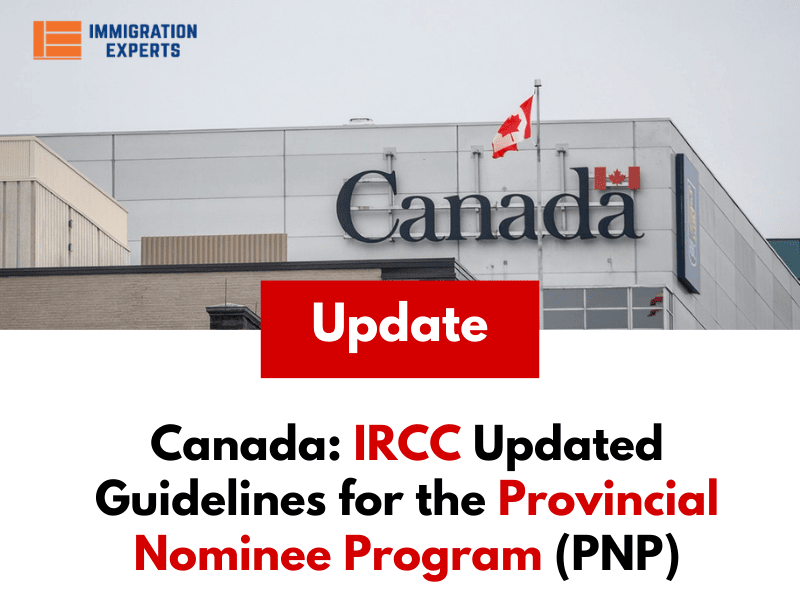051 8439995, 042 35911332

The Immigration, Refugees, and Citizenship Canada (IRCC) recently released new guidelines to help provinces manage the Provincial Nominee Program (PNP). According to CIC News, these fresh guidelines, established by IRCC, outline how they will distribute Provincial Nominee Program (PNP) quotas to various Canadian provinces. This information was shared through a memorandum.
How Provincial Nominee Programs (PNPs) Work?
Each Canadian province faces limitations on the number of candidates it can select through its Provincial Nominee Program (PNP). Annually, the federal government assigns a specific quota of nominations to each province and territory. This allows provinces to pick economic immigrants possessing the necessary skills, connections, or attributes to enhance their workforce and boost their local economy.
The responsibility for immigration is a shared effort between the provinces and the federal government. Nearly all Canadian provinces and territories (excluding Nunavut and Quebec) have their own PNP or a distinct agreement with the federal government to manage this process.
How Provincial Nominee Programs (PNPs) Benefit Candidates?
Individuals who receive a provincial nomination through a PNP have the opportunity to apply for permanent residence through Immigration, Refugees, and Citizenship Canada (IRCC). Notably, candidates within the Express Entry system who secure a nomination also receive an additional 600 points in the Comprehensive Ranking System. This substantial boost significantly enhances their chances of receiving an Invitation to Apply for a permanent resident visa in an Express Entry draw.

Furthermore, candidates can also opt to apply directly to a provincial government for nomination, referred to as a “base nomination.” This offers an alternative pathway to pursue permanent residence in Canada.
Guiding Principles for Provincial Nominee Program Allocations
When determining how to allocate nominations to different provincial governments, the Immigration, Refugees, and Citizenship Canada (IRCC) follows guiding principles. These principles have specific objectives: they aim to establish a framework based on evidence, increase predictability in operations, and enhance transparency in the allocation process. The IRCC also strives to work closely with provinces and territories (PTs) to improve the predictable use of allocations. This includes setting limits on reallocation and redistribution requests.
To make this process more predictable and efficient, the guiding principles are divided into qualitative and quantitative factors. Their purpose is to improve predictability and reduce the need for PTs to request changes.
Quantitative factors take into consideration regional immigration goals, the percentage of economic immigrants compared to the population, and retention rates in each PT. This data helps the IRCC determine the number of nominations in the allocation.
Once the size of a provincial allocation surge is determined, qualitative factors are applied to adjust the numbers. The IRCC actively seeks feedback from PTs and other stakeholders through consultations to better understand their requirements and make necessary adjustments. This includes accounting for other allocations that support regional needs, like the Atlantic Immigration Program (AIP) or the Rural and Northern Immigration Pilot (RNIP).
The document also specifies the AIP, which originally used a population model based on each province’s percentage of the overall regional population. This approach is still applied to the first 2,000 allocations. Allocations are determined based on various factors such as, including historical usage, provincial immigration strategies, and the allocation of economic immigration spaces via Express Entry or the PNP.
Multi-Year Allocations for Provincial Nominee Programs (PNP)
The guiding principles we discussed also apply to the recently approved multi-year plan for the PNP and the AIP. This new multi-year plan is similar to the Immigration Levels Plan, providing provincial and territorial (PT) governments with allocations for the next three years, although these allocations may be subject to adjustments. This marks a departure from the previous one-year allocation system and helps PTs in better planning infrastructure, housing, healthcare, and settlement services for newcomers.
In addition to this, it was revealed that PNP allocations have been increased by a significant 44% for the year 2023.
Plan for Immigration Levels
A new Immigration Levels Plan for 2024-2026 is expected to be released by November 1st this year. This plan will establish the targets for admitting permanent residents over the next three years, shaping Canada’s immigration strategy. In the 2023-2025 plan, the Provincial Nominee Program (PNP) had the highest number of planned permanent resident admissions, starting at 105,500 in 2023 and increasing to 117,500 PNP admissions per year by 2025.
Immigration Minister Marc Miller has indicated that he doesn’t foresee reductions in targets for the upcoming plan. Given the existing high targets and the pressure from provincial governments, any adjustments are likely to involve an increase in PNP admission targets. This reflects a commitment to addressing the immigration needs and priorities of Canada and its provinces.
